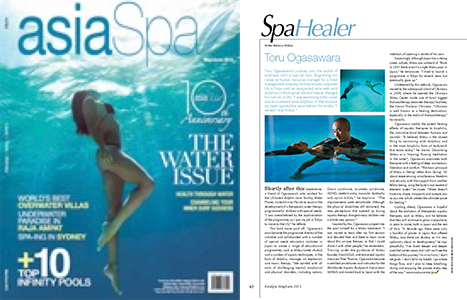アジアのウェルネス関連の雑誌として広く高い評価を得ているAsiaSpaという雑誌の5月号に、小笠原のインタビューが掲載されました。残念ながら日本語版は数年前に廃刊になってしまったので、原文と日本語訳をご紹介します。
Watsu in AsiaSpa May-June Edition 2013
小笠原 徹
小笠原がウェルネスの世界に足を踏み入れた経緯は少し変わっていた。ホテル運営会社での人事部でキャリアをスタートして、東京でのストレスフルなサラリーマン生活を送っていた。ところが予期せずハワイの南国の海でイルカと泳ぐ機会があって、彼の人生に対する見方は大きく変わった。「海の中で野生のイルカと泳いで、今までに経験したことがないほど自分の心が開くのを感じました。」と彼は思い出す。「“帰ってきた”という感覚でした」
この経験の後、小笠原は友人の紹介でアメリカ・フロリダ州のドルフィンスイムの施設でである Water Planet と出会い、障害を持つ子どもたちのためのウォーターセラピーのプログラムを手伝う機会があった。「プログラムの質の高さにビックリして、勢いで会社を辞めてフロリダに飛んでしまいました。」と小笠原は語る。
彼のこの大胆な動きは成功した。小笠原はすぐに現場の指揮をとるプログラムディレクターになり、日本の様々な特別教育の機関と連携して、WATSUほかのアクアセラピー、ドルフィンスイム、マッサージ、アートセラピー、ミュージックセラピーなどを組み合わせた教育プログラムを開発した。「私たちは様々な障害を持った子供たちと関わりました。自閉症やダウン症、トゥレット、ADHD、脳性まひ、筋ジストロフィー、二分脊椎症など」と小笠原は説明する。「効果は劇的でした。本来の症状が良くなるわけではありませんが、アクアセラピーを通じて子どもたちは新しい世界観を体験して、まったく新しい人間に変わることが多々ありました。」
小笠原は自らもプールに飛び込んでWATSUを体験した。「最初のセッションが終わったとき、感動で涙が出ました。絶対に自分でもこのセラピーを学んで、たくさんの人とシェアしたいと心に決めました。」と彼は言う。
小笠原は、WATSUの創始者である Harold Dull や有名なアクアセラピーのインストラクターである Theri Thomas に師事し、WABA公認のプラクティショナーおよびインストラクターの資格を取得した。そして、日本に帰国してWATSUのセンターを開く決意を固めた。
驚くことに、日本は豊かな温泉文化があるのにも関わらず、WATSUはまったく知られていなかった。「2001年の段階では日本にWATSUプールは一つもありませんでした。」と彼は思い返す。「数年間、東京でプログラムを始めようと努力しましたが、結局はあきらめました。」
彼はこの挫折に屈することなく、小笠原は2009年に亜熱帯の沖縄に移住し、アジア最大のタラソセラピーセンターの一つであるかんなタラソ沖縄の中で、沖縄WATSUセンターを開設した。「沖縄は癒しのリゾートとして知られています。海洋療法はその目玉と言えます。」と彼は説明する。
小笠原は、アクアセラピーの癒し効果の源泉はバイオフィリアにあると考えている。バイオフィリアは生まれながらに人間が自然界との間に持つ絆のことである。「個人的に、WATSUはドルフィンスイムに一番近いものだと信じていますし、バイオフィリアを最も強く体験できるセラピーだと考えています。」 この二つのセラピーの共通点は、つながりの心と、安心感と解放感にあると小笠原は説明する。「WATSUの基本的な概念は、doing “やること”よりも“being”を大事にする点にあります。同じ人間に自分の身を委ねて、私たちの根本的なエレメントである水を使って、安心と自由という相反するものを同時に経験することが、究極の癒し空間を作るんです。」
WATSUのようなアクアセラピーの将来の発展を聞かれて、小笠原は、日本でもその他のアジアでもアクアセラピーの人気はこれから何年も伸び続けるであろうと語る。「10年も遡れば、日本にWATSUをする施設は2、3か所しかありませんでした。今では10数か所に増えました。私は楽観的に見てます。」と彼は穏やかに語る。「このワークは本当に深い。この10年間ずっと深く深くと潜ってきましたが、まだ底が見えません。だから自分は急いでいません。目標を設定することもしてません。息をこらえることはしません。呼吸をし続けて、物事が流れる方に流れていけばいいと思っています。そしてその一つ一つのステップを楽しむことだと思っています。」
Spa Healer
Toru Ogasawara
Toru Ogasawara’s journey into the world of wellness isn’t a typical tale. Beginning his career as human resources manager for a hotel management company, he lived a hectic corporate life in Tokyo until an unexpected swim with wild dolphins on the tropical island of Hawaii changed his outlook on life. “I was swimming in the ocean and encountered some dolphins. In that moment my heart opened like never before,” he recalls. “I sensed I was ‘home’.”
Shortly after this experience, a friend of Ogasawara’s who worked for the US-based dolphin swim facility, Water Planet, invited him to Florida to assist in the development of a therapeutic water therapy programme for children with special needs. “I was overwhelmed by the sophistication of the programme, so I quit my job in Tokyo to move to the US,” he reflects.
This bold move paid off. Ogasawara soon became the programme director of the initiative and collaborated with a number of special needs education institutes in Japan to create a range of educational programmes, such as Watsu (water shiatsu) and a number of aquatic techniques, in the form of dolphin, massage, art expression and music therapy. “We worked with all sorts of challenging mental, emotional and physical disorders, including autism, Down syndrome, tourettes syndrome, ADHD, cerebral palsy, muscular dystrophy and spina bifida,” he explains. “The improvements were remarkable. Although the physical disabilities still remained, the new perceptions that opened up during aquatic therapy changed many children into a whole new person.”
Inspired by this, Ogasawara jumped into the pool himself for a Watsu treatment. “I was moved to tears after my first session and decided then and there to learn more about this unique therapy, so that I could share it with other people,” he remembers. Training under the guidance of Watsu founder, Harold Dull, and renowned aquatic instructor Theri Thomas, Ogasawara became a certified practitioner and instructor for the Worldwide Aquatic Bodywork Association (WABA) and moved back to Japan with the intention of opening a centre of his own.
Surprisingly, although Japan has a strong onsen culture, Watsu was unheard of. “Back in 2001 there wasn’t a single Watsu pool in Japan,” he reminisces. “I tried to launch a programme in Tokyo for several years but eventually gave up.”
Undeterred by this setback, Ogasawara moved to the subtropical island of Okinawa in 2009, where he opened the Okinawa Watsu Center inside one of Asia’s biggest thalassotherapy (seawater therapy) facilities, the Kanna Thalasso Okinawa. “Okinawa is well known as a healing destination, especially in the realm of thalassotherapy,” he remarks.
Ogasawara credits the potent healing effects of aquatic therapies to biophilia, the instinctive bond between humans and animals. “[I believe] Watsu is the closest thing to swimming with dolphins and is the most biophilic form of bodywork that exists today,” he claims. Describing Watsu as a “moving, flowing meditation in the water”, Ogasawara associates both therapies with a feeling of deep connection, liberation and comfort. “The basic principal of Watsu is ‘being’ rather than ‘doing’. It’s about experiencing simultaneous freedom and security with the support from another fellow being, using the body’s own essential element: water,” he muses. “Water doesn’t have any shape; it supports and accepts you as you are, which creates the ultimate space for healing.”
Looking ahead, Ogasawara is hopeful about the evolution of therapeutic aquatic therapies, such as Watsu, and he believes that they will continue to grow in popularity in years to come, both in Japan and the rest of Asia. “A decade ago there were only a handful of places in Japan that offered Watsu, now there are dozens; so I’m very optimistic about its development,” he says peacefully. “I’ve dived deeper and deeper over the last ten years, but I still can’t see the bottom of this journey. I’m in no hurry. I don’t set goals. I don’t hold my breath. I go where things flow, and I plan to keep breathing, diving and enjoying the process every step of the way.” www.watsucenter.jp
